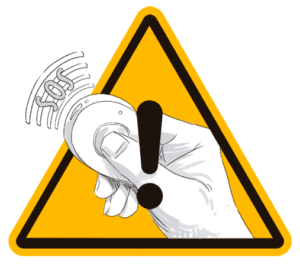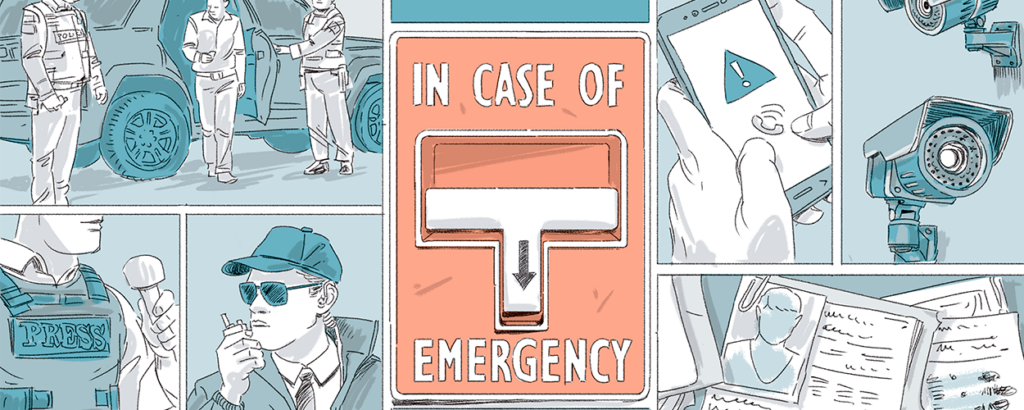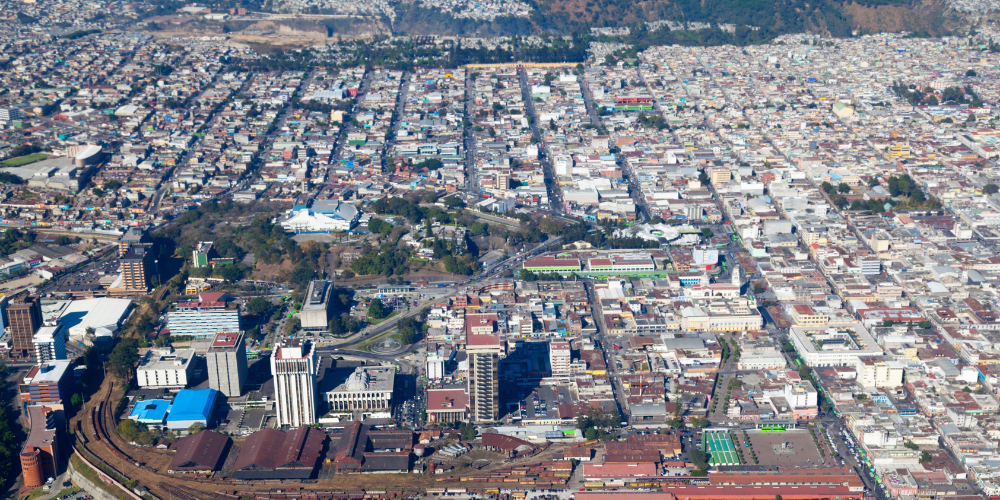By Luis Angel Sas*
This is the third story in a series on protection mechanisms for journalists in Latin America.**

(Illustration: Pablo Pérez - Altais)
On March 8, 2022, the UN High Commissioner for Human Rights, Michele Bachelet, presented a report about Guatemala warning of a climate of attacks and hostility against journalists.
The report mentioned at least 116 incidents of restrictions to freedom of expression documented by the Journalists Association of Guatemala (APG, for its acronym in Spanish) from January to October 2021, and pointed to the urgency of strengthening the protection of journalists.
Ironically, exactly a decade ago, in the same forum, the government of Guatemala had committed to creating a plan to protect press workers in the face of growing attacks.
That happened in 2012 and it still hasn’t been achieved.
The plan was proposed as a result of attacks against journalists in the years prior to 2012. Between 2002 and 2010, 489 complaints were recorded by journalists and four murders of press workers were reported.
But, at the same time, Guatemala had a history of violence against journalists, a legacy of the civil war that lasted from 1960 to 1996 and left more than 200,000 dead and 45,000 disappeared. Journalists and communicators did not escape this violence and according to data from the human rights organization Mutual Support Group (GAM, for its acronym in Spanish), at least 342 journalists were killed and 126 are still missing.
Attacks on journalists continued even after the peace accords. One of the most notable cases was the assassination of Rolando Santiz, the main reporter for the news program "Telecentro Trece," on April 1, 2009. Santiz was gunned down by two men who shot him more than 25 times in the center of Guatemala City. Cameraman Juan Antonio De León was also seriously injured in the attack.
In 2011, another murder confirmed the deterioration of security conditions for journalists. On May 19, Yensi Roberto Ordoñez Galdamez was murdered in the department of Escuintla, about 92 miles south of the Guatemalan capital. Ordoñez had a program on local television and had told his family that he had received a death threat. He left his house on a Wednesday. The next day he was found inside his vehicle with stab wounds to his neck and chest.
The first reaction of the authorities to the climate of attacks against journalists focused on the issue of prosecution, and in 2011, the Attorney General Claudia Paz y Paz ordered the creation of a specific unit against crimes against journalists attached to the Human Rights Prosecutor's Office.
However, later it became clear that the problem had to be confronted from the basis of prevention, seeking to prevent attacks from occurring in the first place.
The government commits
In October 2012, the Guatemalan government committed to developing a Program for the Protection of Journalists to prevent and avert abuses against the press in the country. It was the first year of the Government of the retired general, Otto Pérez Molina.
There was a favorable climate. Pérez Molina, who had been a protagonist in the military coup that unleashed a civil war in the 1980s and later led the opposition party, had built a conciliatory image and was affable with the press. His vice president, Roxana Baldetti, was also close to journalists, far from her image in 1993 when she worked in the Secretariat of Communication of the government of Jorge Serrano Elías and tried to censor the media.
In 2012, ten months into the Pérez Molina government, the country was evaluated by the United Nations Human Rights Council and made a commitment to create a journalist protection program.
A year later, on Nov. 28, 2013, Pérez Molina and Baldetti signed the agreement to start the creation process.
Almost a decade later, Guatemalan journalists still do not have a protection mechanism. The governments following the Pérez Molina administration have broken the promise. The cause is a growing climate of mistrust between authorities and journalists.

(Illustration: Pablo Pérez - Altais)
The beginnings
The distrust was there from the beginning. After signing the agreement to establish the protection mechanism, the responsibility for designing it and putting it into practice fell to Francisco Cuevas, secretary of communication of the Pérez Molina government.
Cuevas had to coordinate other organizations that would participate in the process, such as the Ministry of the Interior, in charge of the Police; the Presidential Human Rights Commission, the Human Rights Ombudsman and the public prosecutor’s office (MP) with the prosecutor for crimes against journalists whose creation was ordered in 2011.
Among the first decisions was to create a high-level table made up of a representative from each institution with the support of the UN Office of the High Commissioner for Human Rights and UNESCO. A technical table would also be formed to advance analysis of the proposal.
The first meetings were held in January 2014. Some of the people who participated in the meetings indicated that under Cuevas' command the creation of the plan did not advance. There were even those who believed that he had no interest in advancing it.
Despite being a journalist himself, a correspondent for the Mexican television station Televisa in Central America for more than 15 years, Cuevas did not have the trust of his colleagues. In 2014, a report by the Committee to Protect Journalists (CPJ) indicated that Guatemalan journalists pointed to specific distrust with Cuevas, not with the entire Guatemalan government apparatus.
At the end of 2014, Cuevas was removed from his position and appointed as Guatemalan Consul in Los Angeles. Karla Herrera, also a journalist who was in charge of communication at the Ministry of the Interior, replaced him.
It was from this change that the development of the protection plan began to advance. However, over the months the errors that buried the initiative would come to light.
The advancements
Initially, the push to advance a protection mechanism was intense. Between 2014 and 2015, almost 90 meetings were held to discuss the model that would best suit the country. Officials relied on the Mexican and Colombian programs to kickstart and shape it.
But, a sector was absent from the meetings to create the protection plan for journalists: the journalists themselves. Herrera, who had been involved in the initiative since she was part of the communication team of the Ministry of the Interior, said that the first meetings were to create the conceptual and organizational framework.
"Here the legal framework for its creation, the financial, human and technological resources were discussed," she told LatAm Journalism Review (LJR).
However, she admitted that it was a mistake not to have shared with journalists a plan that was created to protect them, because the contribution of press workers on crucial issues was lacking.
“We did make that mistake. We did not go to ground with it. We did not engage with journalists who were on the front lines. Those who, we can say, were 'on the street.’ Those who go out every day in search of information,” Herrera said.
Herrera said journalists were left out of answering key questions such as who should be considered a journalist, who was subject to protection, or which authorities the press workers trusted.
To create the protection plan for journalists, the government hired Margarita Castillo, former director of the Penitentiary System (the agency in charge of the country's prisons), who was the consultant in charge of devising the plan.
Castillo also admits that the initiative should have involved journalists, but attributes this error to a lack of budget. She said that meetings were held trying to convene more people, but that the budget to set up working tables was limited.
“It was a weakness, but there weren't enough resources,” she told LJR.
But, according to Castillo, the problem also came from the other side, from the same journalists who did not want to participate. “Journalists did not trust the government. So they preferred not to be part of it,” she said.
Lack of organization
One of the problems that exists in Guatemala is that journalists are not organized in an institution, said journalist Marvin Del Cid, who had to leave the country in 2021 after he was criminally sued, harassed on social networks and was the victim of surveillance after publishing on the country's president, Alejandro Giammattei.
“We found out that they were making a protection plan, but we were never taken into account. We didn't know much about the initiative,” he told LJR.
The plan was presented to several organizations that say they represent journalists, although their membership is very different.
The Guatemalan Association of Journalists (APG) represents reporters and editors, but not from every news organization in the country. The Guatemalan Chamber of Journalism (CGP) is a group of media businessmen and their lawyers and publicists, but not journalists who work for them.
Both groups were presented with proposals for the protection plan, but they and other organizations rejected it, on the grounds that the government would seek regulation of the media.
In a March 2022 meeting after several journalists were attacked on social media, the news website Plaza Pública asked more than 70 reporters and editors if they had been consulted about the protection plan. Only one said yes.

View of Guatemala City from above
Political crisis
The progress of the plan was affected by factors unrelated to the journalists. The first due to the capture in September 2015 of former President Otto Pérez Molina and Vice President Roxana Baldetti, accused of acts of corruption. This temporarily slowed down the working tables.
The second because Pérez Molina's successor in the presidency, Jimmy Morales, never approved the agreement to continue the plan. After Morales was sworn in as president, television producer Alfredo Brito was appointed Secretary of Communication and had to continue creating the plan.
Margarita Castillo, who was in charge of this process, said that the new government should have created an agreement to continue with the plan. In 2018, a draft was sent to members of the technical committee, but was not approved by the President.
Since then the plan has been on hold. Brito was consulted to find out why the plan had not advanced. He requested that the questions be sent in writing, but did not respond.
Since 2018, the plan has been paralyzed. Del Cid believes that if journalists had been consulted for the project, they would have put pressure on it to move forward, but since they see it as someone else's project, no one has questioned why it has been stopped.
Two crimes
On March 10, 2015, while a group of journalists were talking to each other in a park in the city of Mazatenango, about 99 miles south of the Guatemalan capital, two gunmen shot at the communicators. Journalists Danilo López of the national newspaper Prensa Libre and Federico Salazar of radio station Nuevo Mundo died in the act.
This caused the country's journalists to protest demanding justice for López and Salazar, in addition to protection. In 2016, the former International Commission Against Impunity (CICIG) and the public prosecutor’s office presented advances in the crime of the communicators. Then-deputy Julio Suáraez was arrested and accused of paying US$3,200 to the hitmen that killed the journalists. Authorities allege that he worked in concert with local politicians and agents of the National Civil Police (PNC).
On March 18, the trial against Juárez for the death of the two journalists began again. At least one PNC agent who participated in the crime became a state’s witness and testified how he watched the journalists before they were killed.
Although this filled the journalists with hope, it also demonstrated how it is the State itself that attacks them and their work. From 2011 to 2020, 820 complaints were recorded from journalists, according to an Article 19 report. Fifty-seven percent were for threats, 23 percent for coercion and 11 percent for theft. Among these data there is one that worries communicators. There are 46 complaints of abuse by authorities. Most committed by state security agents, who are responsible for providing security to communicators.
The journalist protection plan has been halted. The government has not made efforts to restart it and journalists have lost faith in it. Journalistic investigations have shown how advisers to the government of President Alejandro Giammattei created accounts on social networks to discredit journalists. The same thing allegedly happened with staff from the Guatemalan Congress who used their staff to attack journalists when they published something that made them uncomfortable.
The only real advance in recent years was the creation of a prosecutor's office for crimes against journalists inaugurated on Dec. 10, 2019, but this is for the prosecution of crimes. The plan to prevent them has not seen any progress.
Del Cid has no hope that a mechanism to protect journalists will advance.
“They (the Government) have no interest and we do not trust. So, there is no future for something to move forward at least in this government,” he said.
*The author of this article, Luis Ángel Sas, is a journalist for the site Plaza Pública in Guatemala.
**This is the ninth report in a project on journalist safety in Latin America and the Caribbean. This LatAm Journalism Review project is funded by UNESCO's Global Media Defense Fund.
Read the rest of the articles in this project at this link.
